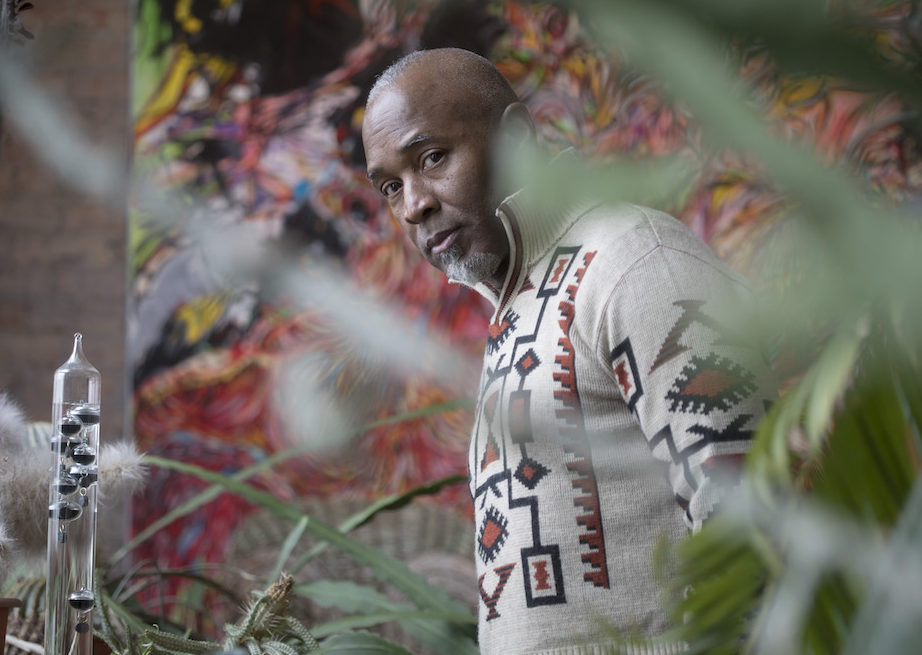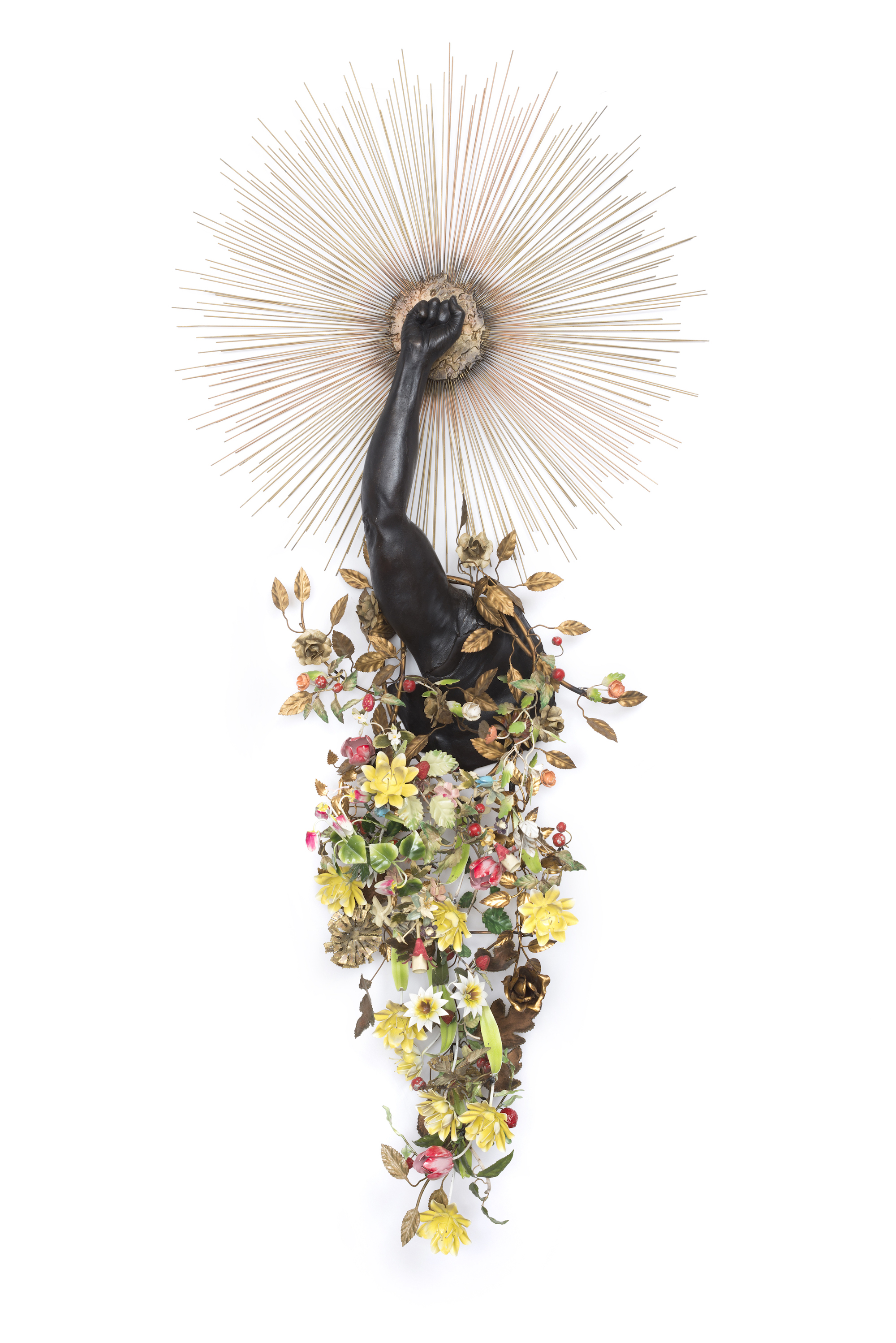
Arm Piece, 2018
It’s mid-January when I meet with Nick Cave to talk about what’s on the horizon for him this year, with two major gallery shows and a new performance commission debuting in New York this summer and autumn. The bright morning Chicago air feels brittle and I’m blue with cold as I huff my way to his studio. I’m running an embarrassing twenty-five minutes late because I got off the L at the wrong stop, forcing me to hoof it over the Cermak Road Bridge which rattles with the kind of bone-chilling breeze I’ve only ever experienced in the Windy City. When I finally arrive, the artist’s studio manager and partner, Bob Faust, graciously ushers me—by then just a popsicle in a puffer coat—into their Pilsen warehouse.
“This used to be the Motor Row District back in the day; our building was an old tire factory,” Faust tells me as we ride the large steel-encased elevator up to their living quarters. “We’re going to move in August, though, we need more space.” The coldness of the building’s industrial design and the Chicago frost still nipping at my earlobes quickly thaws, though, as we stride into Cave’s spacious, sun-spattered, open-plan apartment which is filled with large plants, some small trees even. It feels like walking into a jungle oasis after roving the frigid factory tundra outside.
Cave is sitting at an expansive dark wood dining table, waiting patiently for my late ass. As I sit down, bumbling with apologies, he casually waves his hand to the side in a gesture of absolution, telling me he doesn’t mind having a few extra minutes to himself. “I try to find time to sit in silence every day, it makes you present, brings you closer to your truth. Just imagine if we each had one hour of silence every day! I think we’d be a different people,” he says, his eyes twinkling and clearly a bit bemused by my flustered hurriedness as I pull out my notebook and Faust takes my coat.

“The mobilization of bodies can be just as powerful a force as the weather if we want it to be”
Because of the lushness of the loft, it takes a minute to register all of the art held within it—a Kehinde Wiley painting over there, a Barkley L Hendricks to my right. There are sculptures, tapestries and fantastic furniture everywhere I look from all around the globe, blending to create a roomscape that vibrates with warmth and eclecticism. Cave explains that he’s been collecting all manner of objects for years. “I may be pretty rooted here,” he tells me. He has lived in Chicago since 1980, when he began teaching at the School of the Art Institute of Chicago, “but I’m operating in the world”, he says, gesticulating in an arc. “I like being reminded that I’m out in it, part of it, even when I’m inside.”
Certainly, Cave’s work has always revealed him as having a global world view and even a penchant for collecting. Although perhaps best known for his performances in “soundsuits”—sculptural assemblages used as a surrealist armour to guard against preconceived notions relating to the race and gender of their wearers—the artist’s multimedia installations are even more so a potpourri of found objects exploring class, skin colour and cultural identities. He has two major shows this year at his New York gallery, Jack Shainman, one which opened in May and another which will open in October, both of which attempt to quantify the historical and contemporary psychological condition of black lived experience in America, and have him scouring flea markets and eBay for very specific items.
“I’ve got a whole room full of these carved wooden heads of bald eagles and black people,” he says, which are to be used in his autumn show at Jack Shainman. “We’re all told this is the land of the free and the home of the brave. But who gets to be free, who gets to be brave. These little wooden sculptures, they look similar but they represent different things. What happens when you mix them all together?”
He tells me that his whole process of collection is a political act in and of itself, since as he culls these effigies from random sources, he tries to track down and record the maker and year it was made. “It’s like a reclaiming; a rewriting of history.” There’s all sort of data collection now, all the time, but what about all the information that got left out before now, the names and lives and facts that got lost. “I want to track these things,” he says, “analyse them. There’s power in statistics, it’s a kind of material, too.”
- Tondo, 2018
Data analysis is at the centre of some of his latest fabric “paintings” too, which are featured in Cave’s summer show, Weather or Not
. The large tondos are first bejewelled with a target pattern made out bugle beads before a sweep of colourful fur-like fabric is applied on top in various swirling trajectories. “I was looking at some studies that explore the post-traumatic stress of black-on-black crime,” he says, which is worth noting is vastly overlooked in the mainstream political dialogue around gun violence in America.
“I was struck by how much the brain scans from these studies looked like Doppler maps of severe weather. And that got me thinking about all these devastating hurricanes lately in places like Haiti and Puerto Rico, and how little was done to help these communities,” Cave says, his voice rising a bit. These forces—one natural, one social, but equally damaging nonetheless—that are wiping out people of colour while white America turns a blind eye, and the physical and psychological trauma that ensues among these communities, are precisely what Cave says he’s trying to convey.
Despite the hard-hitting topics that are present in Cave’s work, there is joy too. “There’s always optimism in my work,” he says. “It’s about bringing things to light through colour. Through movement. It’s about activation. That’s when the healing process begins.” Indeed, in his site-specific commission for New York’s Park Avenue Armory this summer, The Let Go, Cave is turning the historic building’s Wade Thompson Drill Hall into a rainbow-coloured dance floor enlivened by nearly one hundred choir members and performers.
“We’re all told this is the land of the free and the home of the brave. But who gets to be free, who gets to be brave”

“We’re in a moment of huge political activation right now—there are huge marches happening in cities across the nation. There are these town halls popping up all over the country and hundreds of people are at them. So I’m taking this idea of the town hall and making it into a dance hall,” he says, explaining that dance is a form of catharsis. “The mobilization of bodies can be just as powerful a force as the weather if we want it to be.”
“I always work with big groups of people these days, it seems to be what the institutions who commission me want,” Cave says simply, when I ask if it’s difficult to coordinate mini-movements all the time.
“May I chime in?” Faust ventures. “I think you might be being too humble. There’s a definite strategy in your work, because when you think of affect, and making a mark, and creating opportunities for people to be seen and heard, the more people you enlist, the more impact your work can have. Your work is about participating in something that’s bigger than the individual. That’s the point about mobilization.”
Cave smiles at me coyly as Faust finishes his sentence. “He’s right. But it sounds better when he says it.” Speaking of mobilizing the masses, the artist checks his watch. “It’s time for me to go to class! I have students to teach.” Within minutes I’m back outside, the heatless sun and chilly air once again shocking my senses. Faust and Cave wave to me from the door. “It’ll be warmer out when we meet again,” the artist says, always the optimist.







